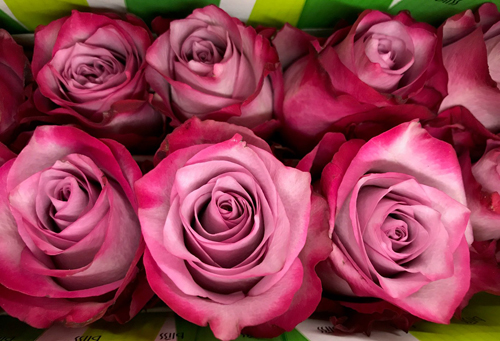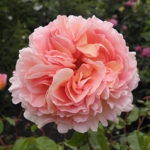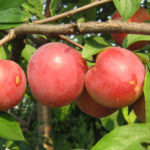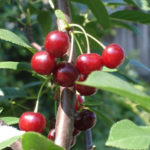Rose Deep Purple
Varietal plants, whose flowers are sustained in cold colors, are distinguished by a special appearance: refined and noble. This is especially true for roses. For example, the Deep Purple variety (Deep purple). It is a novelty of overseas selection and will satisfy even the most demanding flower growers.

History and description of the variety
Rose Deep Purple is a tea hybrid from Ecuador. This variety was bred in 2006 by the AgroCoex rose growing company, which began its existence in the 90s. last century as a family business. The name of the plant is translated from English as "dark purple", which indicates the peculiarity of the color of the inflorescences, although in fact the latter includes several shades. This culture attracts attention thanks to the fabulously beautiful lilac-pink cupped flowers with crimson and lilac tints. It is noteworthy that at the base, the wide flower petals are lighter, while a darker crimson border is noticeable at the edges. These color transitions make the terry inflorescences of the exotic variety very effective. An open rosebud in diameter is 10 - 12 cm, half-open has a goblet shape and looks quite lush. The number of petals in each inflorescence varies from 30 to 45 pieces. The flowers of the Ecuadorian beauty exude a pleasant, unobtrusive aroma with romantic notes. As a rule, they are solitary, but it happens that they are also formed in groups of 2 - 4 pieces on the stem.
The flowering culture is abundant, undulating. It continues throughout the summer period, ending only in late autumn. Wonderful flowers stay on the rosebush for a long time. In height, a decorative perennial usually does not exceed 100 cm, in width it grows by 0.7 m. It is quite compact and does not fall apart during flowering. The shoots of this noble plant are straight, strong, firm, firm; leaves are dark green, shiny.

Deep purple is very resistant to fungal diseases and has high winter hardiness. Rain does little harm to the beautiful inflorescences of this variety, unless it is prolonged precipitation. As for the heat and direct rays of the sun, the first can provoke the caking of flower petals, and the second - their burnout.
Growing and care
To plant a plant, you should choose a place where there is a lot of diffused sunlight. Placing shrubs in the shade will cause low productivity of the variety. It is necessary to plant a crop on slopes or a flat place. Lowlands are categorically not suitable for these purposes. In addition, the section of the site where you plan to cultivate the adorable flower should be protected from cold drafts and gusty winds.
Rosa Deep Purple loves light, fertile soils with good air and water permeability, with a slightly acidic reaction. The need for a layer of drainage material at the bottom of the planting pit cannot be neglected. Using ordinary garden or garden soil as a soil for a rose, it needs to be improved. For this, components such as humus, sand, peat, compost are introduced into the soil. Vermicompost will not hurt either. The recommended planting pit depth is at least 50 cm, since the plant roots in it should be free. After the plant has been planted, the soil around it should be tamped, and the culture itself should be watered under the root with settled water at room temperature.

You need to take care of the plant, like any other tea hybrid. It should be watered on time, preventing the earthen coma from drying out; feed with organic and mineral fertilizers; in the spring to get rid of dried branches and shoots with damage, and in the fall, before the onset of cold weather, it is imperative to spud with peat or dry soil. For the winter, it is advisable to cover the perennial with non-woven material, dry foliage or spruce branches, despite its excellent frost resistance.Warming is especially necessary for young culture and shrubs cultivated in the middle lane or in the northern region.
Do not give up the preventive treatment of roses with insecticides and fungicides. Periodically, you need to loosen the soil under the bush, and after watering, mulch the soil in the zone of the trunk circle. This will make it easier for the plant to breathe, protect it from weeds and extend the time that moisture is in the soil by reducing the frequency of watering. By the way, it is recommended to water the cold beauty in the evening or in the morning with soft, slightly warm water.
In the summer, it is important to remove dried inflorescences on the plant in a timely manner in order to stimulate the appearance of new buds. In the year of planting, it is better not to let the culture bloom - this way you will achieve more lush and abundant flowering in subsequent years.
Use cases
The Deep Purple variety is suitable for planting alone and in groups in the foreground of the site, against the background of a green grass lawn, near gazebos, garden fountains, artificial ponds, sculptures and benches. A bush with lilac-lilac flowers will look great at the front entrance to a dwelling or garden, on the sides of paths, along the fence and at the facade of the house. This plant can be safely included in the hedge, placed in mixborders and rabatkas, on round classic flower beds. Mixed compositions with the participation of the Ecuadorian rose are amazing. It is excellently combined with low-growing conifers (boxwood, dwarf pine and spruce, junipers, globular thujas), trees and shrubs (white turf, European forsythia, Thunberg barberry, chanomelis, louisania), ornamental grains, fragrant herbs (lavender, thymus, sage oregano, yarrow), plants with silvery leaves (hosts, wormwood), various flowering annuals and perennials (verbena, veronica, daisies, cuffs, irises, lilies, geraniums, bells, daylilies, clematis, Mexican ageratum). It is important that the inflorescences of neighbors in such a composition harmonize or contrast with each other, since such combinations look the most advantageous. Using this rule, next to our heroine, plants should be planted with flowers of pale pink, light yellow, purple, blue, raspberry, lilac, lavender shades.
Deep Purple is also actively grown as a cut-off variety. Its aristocratic inflorescences stand in the water, keeping their freshness, classic shape, wonderful shade and light aroma for up to two weeks. It is pleasant to receive a bouquet of lilac flowers mixed with pink, lilac and crimson colors as a gift for a birthday, wedding celebration, graduation party, professional holiday.








